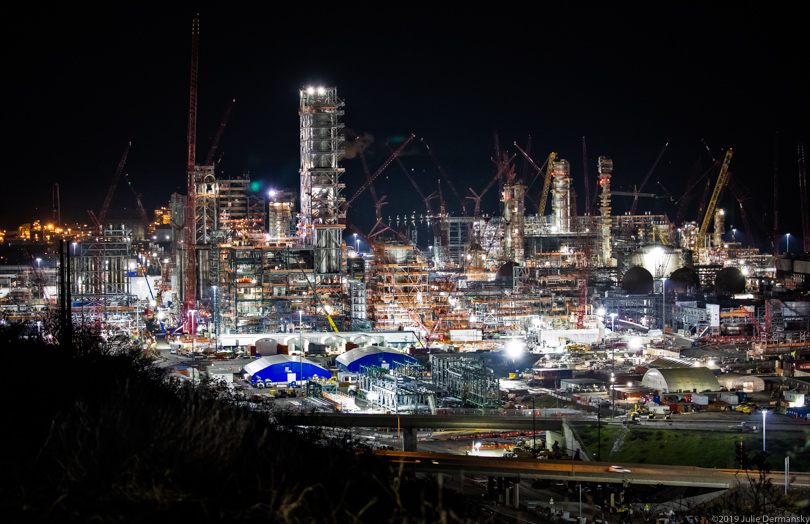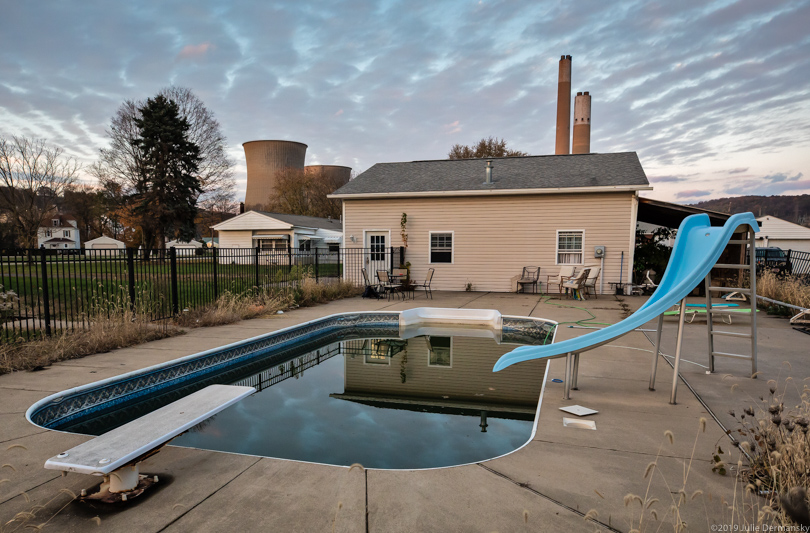For Beaver County, just northwest of Pittsburgh, the construction of Royal Dutch Shell’s towering new plastics factory overshadows the closure of the Bruce Mansfield Power Plant, the state’s largest coal power station, located along the same stretch of Ohio River in western Pennsylvania.
The juxtaposition of these two projects, in which one powerful fossil fuel supply rises as the other falls, reflects the broader pattern of changing energy sources in America. A growing chorus agrees the expansion of the natural gas industry, which feeds plastics and petrochemical plants like Shell’s, is moving the U.S. in the wrong direction to prevent catastrophic impacts from climate change.
Shell’s plastics plant, also known as an “ethane cracker,” under construction in Beaver County, Pennsylvania.
A home in Shippingport, Pennsylvania, near the closed Bruce Mansfield Coal Plant.
A Global Mismatch: Climate Plans vs. Fossil Fuel Plans
Scientists have warned that if the world doesn’t limit global temperature increase to 2.7º F (1.5º C) above preindustrial levels, called for in the 2015 Paris Agreement, we won’t be able to prevent the most severe effects of global warming.
A November 20 report from the United Nations Environment Program assesses the gap between Paris Agreement climate goals and countries’ planned production of fossil fuels. The report states that “the world is on track to produce about 50 percent more fossil fuels in 2030 than would be consistent with limiting warming to 2°C and 120 percent more than would be consistent with limiting warming to 1.5°C.”
While coal is the biggest driver, according to the report, “Oil and gas are also on track to exceed carbon budgets, as countries continue to invest in fossil fuel infrastructure that ‘locks in’ oil and gas use.”
The shale gas industry has been building demand for fossil fuels from its fracked oil and gas wells by promoting turning its products into plastics and petrochemicals.
A close-up of Shell’s sprawling plastics plant under construction in Beaver County on November 7.
DeSmog’s Sharon Kelly has created a field guide to the petrochemical and plastic industry and reported on the climate impacts of building a new petrochemical corridor in America’s Rust Belt and expanding the existing corridor, and Louisiana’s Cancer Alley, on the Gulf Coast.
At the forefront of this buildout, the Shell Petrochemical Complex under construction in Beaver County is designed to take ethane from the region’s natural gas fields and transform it into polyethylene, a plastic used in consumer products like food packaging and car parts.
Climate and Air Pollution Concerns for the Ohio River Valley
At a packed November 6 public meeting at the Beaver Library, residents from Beaver County and Pittsburgh’s greater metropolitan area expressed growing concerns about how the Shell plant could degrade the area’s already compromised air quality and affect public health.
Matt
Matt Mehalik, executive director of the advocacy group Breathe Project, presented a slideshow about the plant and the buildout of the petrochemical industry in the Ohio River Valley. He labeled the Shell plant’s annual permitted 2.2 million tons of carbon dioxide emissions “a disaster from a climate perspective.” He then pointed to the Cheswick Power Plant, another old coal station 18 miles northeast of Pittsburgh, as a comparable carbon polluter.
Polar bear outside of a closed restaurant near the Cheswick coal power plant in Pennsylvania’s Allegheny County.
Climate pollution isn’t the only concern for a region which has received an ‘F’ grade for high ozone days (the main component of smog) and particulate pollution in the American Lung Association’s 2019 State of the Air report.
Shell’s plastics plant could be joined by similar plants proposed nearby, including PTT Global Chemical’s in Belmont County, Ohio, which would also affect regional air quality. And rumors that ExxonMobil has been searching in Beaver County for a suitable location to build a petrochemical plant like Shell’s have many worried that the area will become too polluted to live in.
Fossil-Fueled Plastics Production
These petrochemical complexes are also known as “cracker plants” or “ethane crackers” because they heat up the natural gas liquid ethane in order to “crack” it into ethylene and can further refine that into the polyethylene pellets called “nurdles” used to manufacture plastic products. Cracker plants run on feedstock produced by fracked gas wells that are already plentiful in Pennsylvania.
According to the Breathe Project, a single petrochemical plant would require industry to open more than 1,000 new well pads every 3 to 5 years to supply feedstock for plastic manufacturing. And some Pennsylvania residents are already up in arms about polluted air, soil, and water issues created by the fracking industry statewide since the fracking boom began in 2008.
“We are locking into place an infrastructure with natural gas-fired power plants that will guarantee that our carbon emissions will go up over time,” Mehalik warned. “It is exactly the wrong time for that to happen — that is when the window actually to stop runaway climate change will close.” He pointed out that while the state’s carbon footprint started going down due to closing coal power plants, those gains are being offset by new natural gas-fired power plants and a growing petrochemical industry.
This month saw the country’s two biggest coal power plants shut down, Pennsylvania’s 2.7 gigawatt (GW) Bruce Mansfield Plant and Arizona’s 2.25 GW Navajo Generating Station. The closures have major climate implications. Their combined carbon dioxide emissions between 2010 and 2015 were nearly equivalent over that same time to the 15 GW of coal plants that closed in 2015, according to E&E News.
From Coal and Nuclear to Natural Gas?
Meanwhile, community members in Shippingport, a small neighborhood sandwiched between the Bruce Mansfield Power Plant„ and the Beaver Valley Nuclear Power Station, slated to close in 2021, worry about the natural gas industry looking to take over their small town. Both the coal and nuclear plants are owned by FirstEnergy Solutions.
Workers at the Bruce Mansfield Coal Plant the day before it shut down.
William Green on a walk in Shippingport, with the Bruce Mansfield Coal Plant behind him.
While I was taking photographs of the homes between the two plants, William Green, the former Borough Manager for Shippingport, told me people in his small community of about 250 worry that Shell is planning to buy both FirstEnergy plants, as well as the entire town. He said that there is talk that the plants could be converted into natural gas power plants.
At the November 6 community meeting in the town of Beaver, Mehalik asserted that replacing coal plants with natural gas plants won’t save us from climate catastrophe and that when natural gas is converted into feedstocks to produce plastics, it generates enormous carbon dioxide emissions.
“Petrochemical industry expansion is completely contradictory to the principles of addressing climate change, improving air quality, protecting water, and pursuing a sustainable and resilient community approach to regional development.” A November 20 press statement from the Breathe Project stated, “Turning any region into a massive petrochemical hub is a huge step in the wrong direction on climate change when we should be investing in clean energy, not fracking and plastics.”
What Louisiana and Pennsylvania Have in Common
Environmental advocates and activists have been trying to stop the growth of the petrochemical industry in Louisiana for the same reason. The proposed Formosa petrochemical complex in St. James, Louisiana, would generate enormous greenhouse gas emissions in the process of converting natural gas into the feedstocks to produce plastics.
If permitted, it will be able to emit 13.6 million tons of carbon dioxide per year, the equivalent of three coal-fired power plants, Corinne Van Dalen, an attorney with Earthjustice working with community members to stop the plant, told Rolling Stone. Among 219 currently proposed oil and gas projects in the U.S., the Environmental Integrity Project found that the Formosa plant would release the most carbon dioxide, by a wide margin.
Environmentalists in Pennsylvania and Louisiana, both shale-rich states, have to contend with industry capture of regulators and politicians. Fossil fuel industry projects are approved despite concerns raised about insufficient environmental impact studies or climate impacts. Concerned citizens in both states have accused regulators of serving industries’ needs instead of protecting people and the environment.
Pittsburgh Mayor Bill Peduto tapped into that sentiment at the city’s Climate Action Summit on October 30 when he expressed his opposition to new petrochemical industry development. “We do not have to become the petrochemical/plastics center of the United States,” he declared to hundreds of attendees at the summit. His comments continue to ripple through western Pennsylvania.
A group of bipartisan elected official in western Pennsylvania counties issued a statement on November 20 in support of natural gas and petrochemical development in the region, dismissing the mayor. “So, while Mayor Peduto may speak for one city, we speak for the rest of this region,” the officials wrote. “To those in the natural gas and petrochemical industries, hear us when we say: Western Pennsylvania is open for business.”
Members of the Breathe Coalition have rallied in defense of the mayor for opposing the petrochemical buildout. “We would rather see such support go to jobs and projects that promote health, extend lives, and support frontline communities,” Mehalik wrote in a November 20 Breathe Coalition press release. “We know that through innovation, we can create jobs, grow the economy, clean up our communities, and protect our health. We support leaders who commit to doing this.”
Main image: Resting angel on a tombstone in Bethlehem Cemetery in Shippingport, Pennsylvania, next to the Bruce Mansfield coal power plant. Steam in the background rising from the Beaver Valley Nuclear Power Station. Credit: All photos by Julie Dermansky for DeSmog
Subscribe to our newsletter
Stay up to date with DeSmog news and alerts














